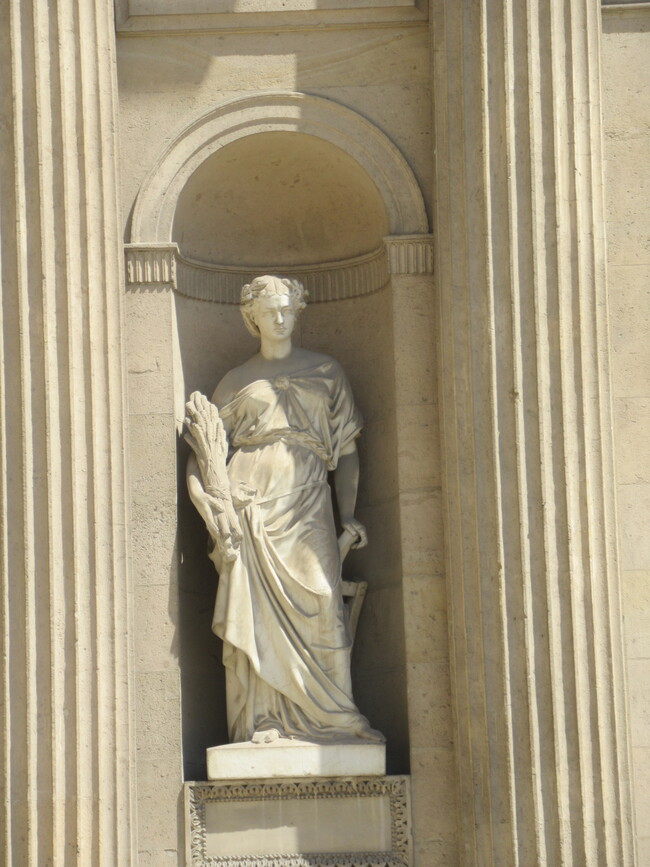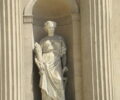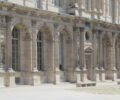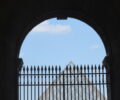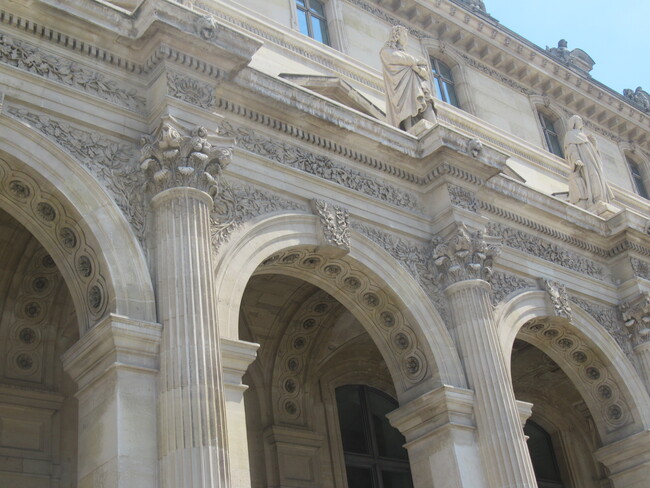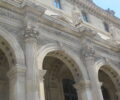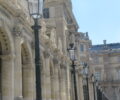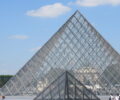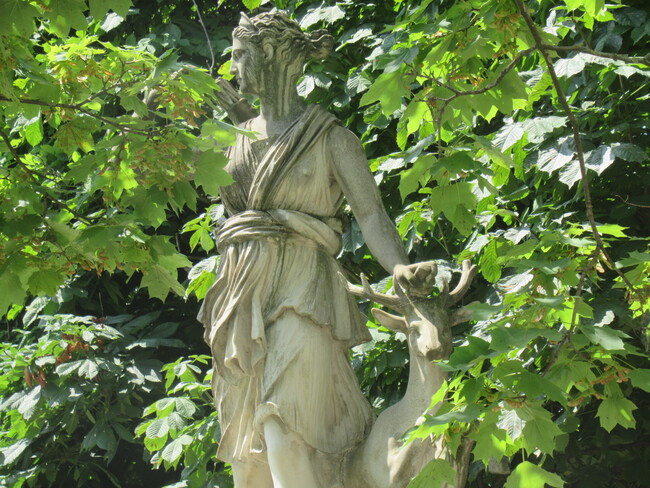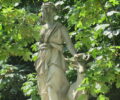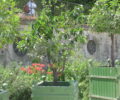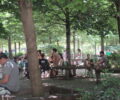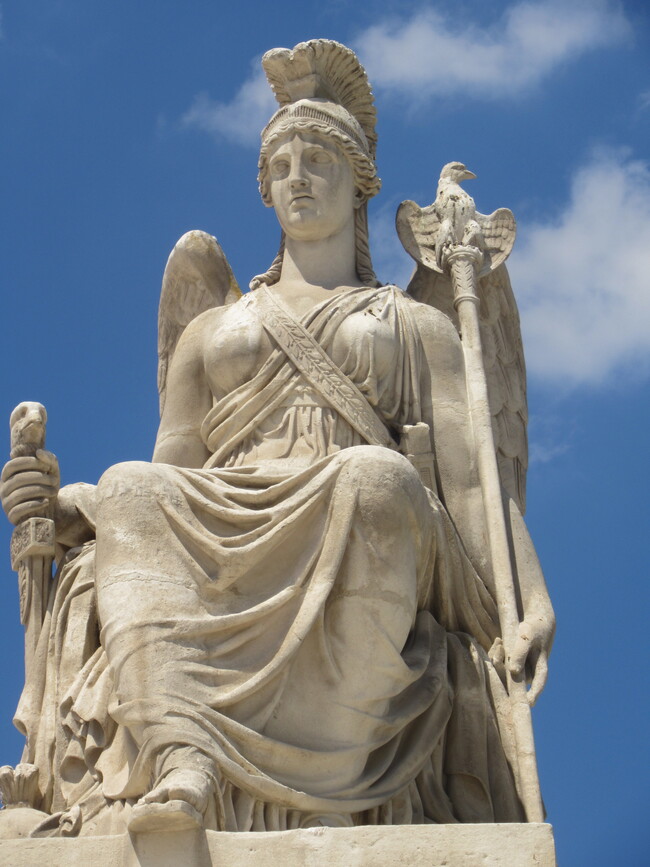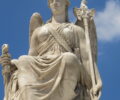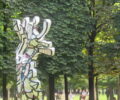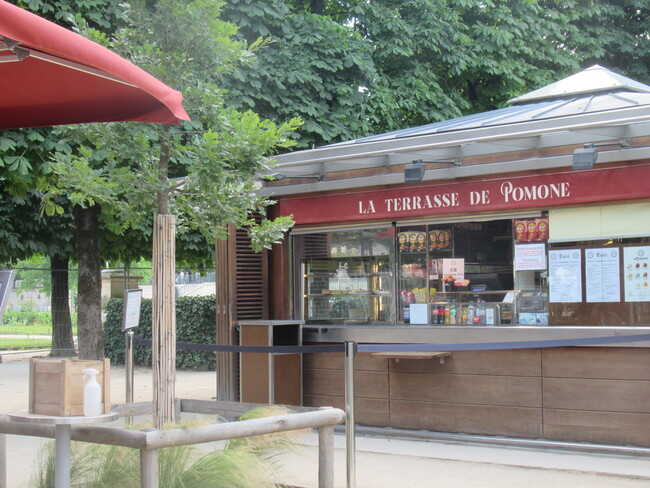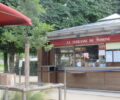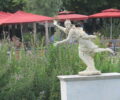Flâneries in Paris: The Louvre and Jardin des Tuileries
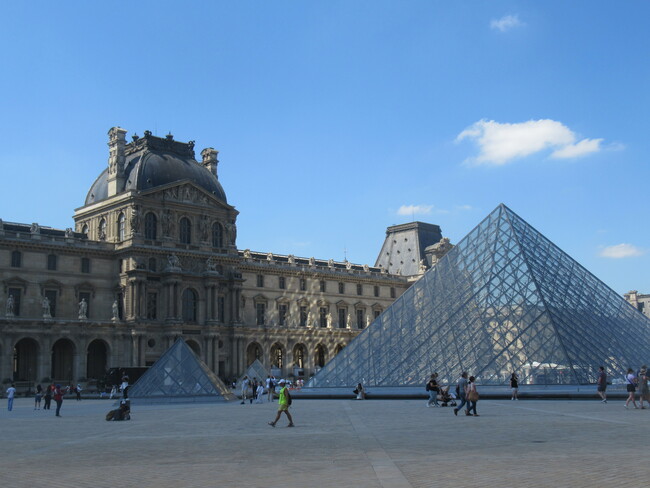

- SUBSCRIBE
- ALREADY SUBSCRIBED?
BECOME A BONJOUR PARIS MEMBER
Gain full access to our collection of over 5,000 articles and bring the City of Light into your life. Just 60 USD per year.
Find out why you should become a member here.
Sign in
Fill in your credentials below.
This is the 33rd in a series of walking tours highlighting the sites and stories of diverse districts of Paris.
Starting une flânerie outside the Louvre was always going to be splendid. I gazed up past the pyramide to the far end of the courtyard, where a row of archways beckoned. “Can I go through there?” I asked someone in a high-viz jacket. The poor man probably spends his day being interrupted by inquisitive visitors, but he happily dispensed a little gallic charm. “Ah yes, to the Cour Carrée, Madame?” he smiled. “Allez-y. On vous attend.” (“Go ahead, they are expecting you.”)
The Cour Carrée is the site of the original Louvre building, known today as the Sully Wing. It sits atop treasures from earlier centuries, such as Philippe Auguste’s fortress, the remains of which you can still visit on the lower ground floor. From the outside, it’s the geometry of a perfect square which impresses and the exquisite façades with their arches, pillars and little statues set back in niches. The classical design was begun during the renaissance by Pierre Lescot, much inspired by his travels to Italy in the 1550s. From the center, I could admire the whole, from the edges I could peek through at such lovely vistas as the pyramide, resplendent in sunshine against a vivid blue sky, and through it, more distant, the Arc de Triomphe du Carrousel.
Back through the arches, the Cour Napoléon was equally stunning: ribbed pillars with matching carved tops, rows of tastefully decorated arched entrances, stately lampposts lined up at precisely regular intervals. All very perfect, although I smiled when I recalled the description I’d seen online of the decorative features along the first-floor facade: “86 statues of famous men.” They included the likes of Jean-Jacques Rousseau and the Marquis de Vauban who worked such architectural wonders for Louis XIV. Fair enough. But I saw many apparently illustrious men I’d never heard of – my ignorance, I’m sure – which did make me wonder whether room couldn’t have been found for, say, Joan of Arc or Olympe de Gouges.
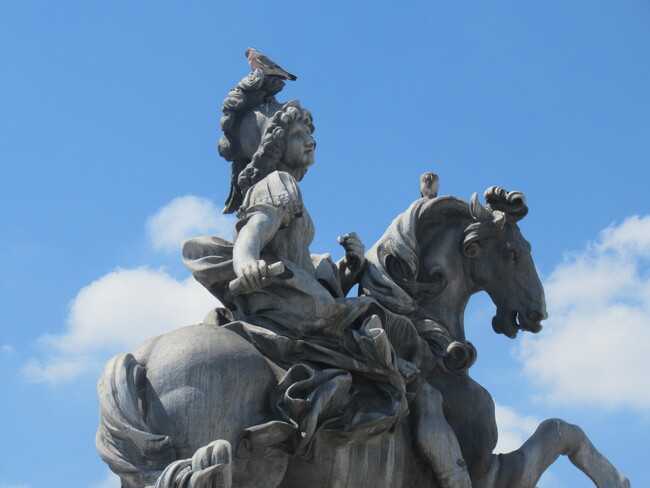
Cour Napoléon, Louis XIV statue. Photo: Marian Jones
The square is named after Napoléon and dominated by a statue of Louis XIV on horseback, but I think both would be outraged to find they have been eclipsed by a geometric shape. I M Pei’s vast glass and steel pyramid draws the eye from every direction and in today’s sunshine it’s a glistening beauty, a prism through which to see the old charms of the Louvre’s architecture anew. I recalled the arguments which raged when it was erected. Too Disney, so out of place, really just President Mitterand’s vanity project and anyway isn’t a pyramid a symbol of death? I think Parisians have generally got over the shock and for what it’s worth, I like it. It can be dismal in drizzle, but on a sunny day – wow!
Crossing the road towards the Tuileries Garden, I came straight to the Arc de Triomphe du Carrousel, built by Napoleon to honor his Grande Armée after their victory at Austerlitz. It’s true that white marble statues of eight of his soldiers sit on top of Corinthian columns, but really the project was a tribute to himself! Bas-reliefs recall his victories – “The Surrender at Ulm” and “Napoleon entering Vienna,” for instance – and he had it placed here, just at the entrance to the Tuileries Palace which served as his official residence at the height of his powers. However, the gilded horses right on top are copies because the originals, stolen from St Mark’s Square in Venice, were sent back after the Emperor’s defeat at Waterloo.
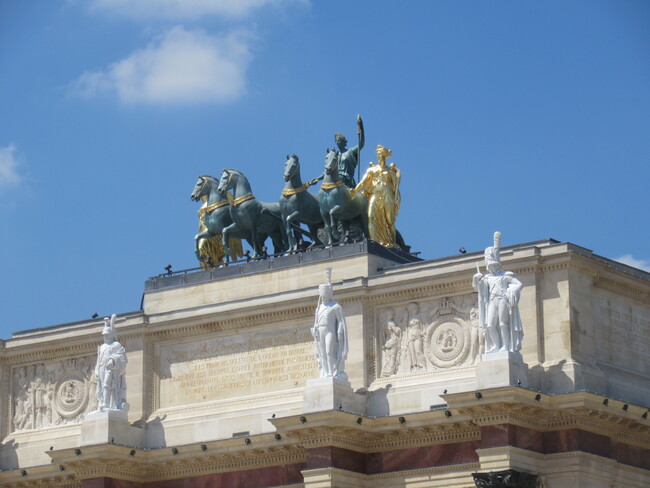
Arc de Triomphe du Carrousel. Photo: Marian Jones
The recently completed restoration of the Arc was paid for by donors and contributions from the public, underlining its continuing place in the affection of Parisians. It is, after all, the beginning of Napoleon’s magnificent Voie Triomphale, the stunning vista which extends along the Champs Élysées to the Arc de Triomphe. Such is the pride in Napoleon’s grand vision that Paris chose to mark the 200th anniversary of the French Revolution by extending his “Triumphal Way” out to the western suburbs and finishing it with another great flourish: the Grande Arche de la Défense. Delightfully, a walk in that direction would take me straight through the Tuileries Garden.
What began as flower and vegetable garden for Catherine de Medici to admire from her rooms in the Tuileries Palace was transformed in the 17th century by Louis XIV’s gardener, André le Notre. His creation, once a playground for royal children and a space near the palace where visiting nobles could meet to plot and scheme, was only gradually opened to the public, but the mood today was jolly. Picknickers lunched near classical statues, toddlers loped around after pigeons, couples photographed each other with a glimpse of the Eiffel Tower or the Obelisk at Place de la Concorde in the background. I passed a group playing boules, one of whom paused to explain that “we meet here every week to play.”
I find the mix of formality and creativity in the design of the Tuileries very French. The framework of straight lines and geometric shapes is orderly, yet as I meandered, it felt as if there might be a little surprise around every corner – an unexpected statue or a perfect set of pale green planters filled with a tumble of plants. Le Nôtre’s structure, still largely unchanged today, has a central Grand Allée with a large round pond at one end and an octagonal one at the other, where a lesser designer might have made them the same shape. In the central section, the Grand Couvert, he planted a different species of tree in each of eight rectangular groves, so again symmetry with a dash of individuality.
I kept coming across statues and was struck by their variety. Next to the Arc du Carrousel sits La France Victorieuse, commissioned as part of Napoleon’s redesign, a triumphant winged female figure, dressed in classical robes and oozing patriotic pride. I passed mythological figures like the lovely Diane à la biche, the goddess of hunting, standing with a female deer. Actually, she’s a copy because the original is now inside the Louvre, shielded from the weather. A complete contrast was Dubuffet’s Bel Costumé, a startling model which I took to be a man with wild hair waving at me, all crafted in white resin with red, blue and black lines. Google told me he was an example of the hourloupe style from the 1950s. He was certainly a contrast to the classical art and a fun surprise to happen across.
The cluster of little tables with red umbrellas at La Terrasse de Pomone was an enticing prospect. A cheerful nymph statue pointed the way, perhaps Pomone herself? I looked her up too and found, fittingly, that she was the Roman goddess of fruit, said to favor well-tended gardens over nature in its wild state, so really the perfect symbol for this idyllic spot where generations of gardeners have teased ordered perfection from the soil. Every flânerie benefits from a café stop and what could be nicer than this one, with its sunny tables and pond-side setting?
I paused over a cool drink and looked around. A group of school children bickered lightly on the grass near the water’s edge. “Tu crois? Moi, je ne crois pas.” (“You think so? I don’t think so.”) A troop of ducks waddled past my table. Two large ladies in flowery dresses sailed by and inadvertently committed a faux pas. They ignored the waiter’s greeting – Bonjour, mesdames – and carried on past him to choose a table. He made an exasperated gesture with his tray and followed them, calling out “Oh la la, la la, la la.” I wrote it down verbatim and assure you that I have not invented a single syllable. But, ever the professional, and perhaps realizing they spoke no French, he tailed them to their chosen table and politely handed them la carte.
There’s nowhere quite like the Tuileries. I’d passed a working tractor and some gardeners clipping bushes, reminding me that it’s very much a garden. I’d seen enough families and lunching office workers to show that it’s a welcome green space in the middle of a city. The statues made it an open-air museum. Passing the Grand Bassin Rond and remembering the golden balloon which floated high above it every evening during the Olympics, I knew that it is, and always will be, one of the symbols of the city which makes Parisians proudest. It’s a cliché, but yes, it’s one of my very favorite spots in Paris.
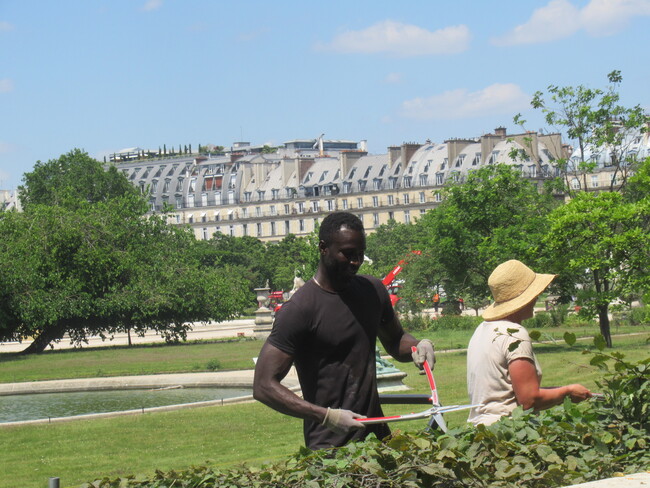
Gardeners working in the Tuileries. Photo: Marian Jones
Lead photo credit : Cour Napoleon, Louvre. Photo: Marian Jones
More in Flâneries in Paris, Louvre, Tuileries, walking tour
